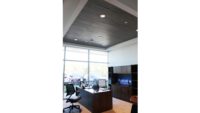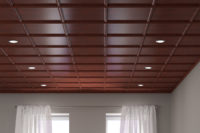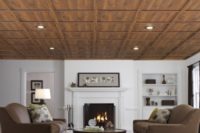What is the difference between sound and noise? Technically, there is no difference, noise is simply unwanted sound that is distracting, often to the point of being annoying. While sound masking simply masks noise with more desirable sound and sound baffles disrupt and possibly absorb some sound waves, sound attenuation can best be achieved with sound-absorbing paneling. PET (Polyethylene terephthalate) fiber is the most common material used in the manufacture of synthetic felt and fiberboard for sound baffles and wall and ceiling panels. Some suppliers have printed PET panels in an attempt to make them look more like wood. Not only does this process fail to make the PET look remotely like real wood, it likely compromises the sound absorption properties of the panels. To achieve the look and feel of real wood while maintaining the sound attenuation properties of PET fiberboard, Canadian manufacturer factor-e-direct Inc., developed their proprietary BTW (Better Than Wood) ceiling and wall panel system.
How do they do this? factor-e-direct developed machines to laminate California (Prop 65) compliant embossed PVC to ½” T x 8” W x 7’-4” L PET fiberboard planks which are ironed on the underside to melt the surface, creating a counterbalanced force to keep BTW planks flat. A hot needle roller then micro-perforates the PVC to enhance sound transmission while knives cut blind-slits into the edges of the laminated planks to accept the patented “Snap Clips” used to mount BTW planks to a T-Bar grid and “Alignment Splines” to align the PVC surfaces of the planks. BTW planks are available in 6 standard wood finishes, Walnut, Cherry, Gumwood, Barnwood, Expresso Mahogany, and Blonde Ash which can be used for wall and ceiling paneling, create a cornice, or sound attenuation cloud.









Report Abusive Comment